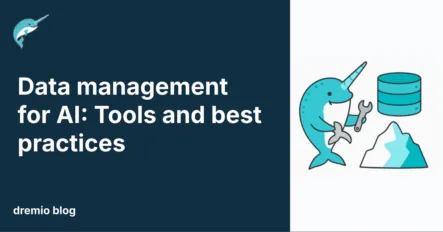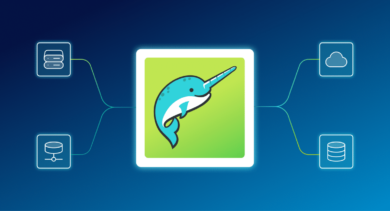17 minute read · November 3, 2025
Data management for AI: Tools and best practices
· Head of DevRel, Dremio

Building AI solutions isn’t just about algorithms, it’s about the data that powers them. For AI models to be accurate, reliable, and safe, enterprises must modernize how they collect, store, govern, and serve data. This requires data architectures that support openness, scale, and governance from the ground up.
This blog walks through the tools, techniques, and principles that define AI-ready data management, how it differs from traditional approaches, and what enterprises can do to optimize their stack for real-world AI use cases.
What is data management for AI?
AI data management is the practice of preparing, organizing, governing, and serving enterprise data so it can be used effectively by AI models and agents. It includes collecting data from multiple systems, maintaining high data quality, enforcing governance, and delivering fast, consistent access to that data for training and inference.
Unlike business intelligence pipelines, AI data management supports iterative, high-throughput workloads. It enables systems to adapt to changes in schema, input size, and query complexity, especially when real-time or semi-structured data is involved.
Dremio supports AI-ready architectures through open formats like Apache Iceberg, low-latency access using Apache Arrow, and zero-ETL federation across your existing environments. Learn more about how Dremio enables machine learning operations on AI-ready data.
AI data management vs. traditional data management: Key differences
Traditional data management evolved to support dashboards and compliance reporting. But AI requires broader access, faster iteration, and richer semantics. Here's how AI data management differs:
- Format and structure flexibility
AI workloads often involve unstructured, semi-structured, and time-series data. Systems like Iceberg enable schema evolution and time travel, critical for AI experimentation. - Openness over lock-in
AI ecosystems must integrate with many engines and tools. Vendor-locked formats restrict this. Iceberg’s open standard removes that barrier. - Automated performance optimization
Traditional systems rely on manual tuning, and AI-ready platforms like Dremio support autonomous optimization that adapts based on query patterns. - Semantic context for humans and machines
AI data isn’t just raw tables; it requires business logic and metadata to be usable. The unified semantic layer in Dremio helps bridge that gap for both people and LLMs.
Try Dremio’s Interactive Demo
Explore this interactive demo and see how Dremio's Intelligent Lakehouse enables Agentic AI
Why data management is important for AI
AI systems can't function without access to consistent, high-quality, and well-governed data. Here's why data management is foundational to AI success:
- Data quality shapes model outcomes
Poor inputs lead to poor predictions. A single missing field or duplicated record can skew results, especially in supervised learning or decision systems. Dremio helps teams streamline data quality checks at scale. - Governance is non-negotiable
AI use increases regulatory exposure. Enterprises must ensure data access follows compliance frameworks like GDPR or HIPAA. With lakehouse governance, Dremio provides native controls to reduce risk. - Latency and scalability drive performance
Whether it’s training an LLM or deploying real-time recommendations, performance bottlenecks stall AI workflows. Dremio uses Arrow Flight and Iceberg clustering to deliver sub-second responses across distributed data. - Semantic meaning improves accuracy
Without business context, AI agents struggle to interpret columns or join datasets. Dremio’s Model Context Protocol (MCP) ensures AI agents understand the data they’re querying.
What are the core components of AI data management?
AI data management isn’t one tool, it’s an architecture made up of interconnected systems that support collection, access, governance, and optimization. Here are the core components:
- Open data lakehouse foundation
A lakehouse architecture supports open table formats like Apache Iceberg, allowing you to store structured and semi-structured data with schema evolution and version control. Explore how Iceberg powers AI data management. - Federated query engine
Federated access eliminates ETL bottlenecks and lets teams query all sources, cloud storage, databases, apps, through a single SQL interface. Learn how Dremio’s data federation simplifies this. - Unified semantic layer
Context is critical for humans and AI agents. A semantic layer embeds business meaning directly into datasets, ensuring consistency and accuracy across tools. Dremio’s unified semantic layer enables this with built-in governance. - Performance acceleration
From query caching to intelligent clustering, AI workloads demand real-time data access. Dremio supports autonomous optimization that adapts in real time, no tuning required. - Governance and catalog
With data privacy regulations and risk exposure on the rise, teams need centralized lineage, access controls, and audit logs. Dremio delivers this natively with lakehouse governance.
Data management requirements for AI
To support AI systems in production, your data infrastructure must meet specific technical and operational requirements:
- Open formats and API access
Avoid lock-in with formats like Iceberg and tools that support standard APIs, ensuring AI systems can read/write data without restriction. - Low-latency access to source systems
AI systems rely on up-to-date data. Dremio provides real-time data virtualization that delivers live access to source systems without replication. - Integrated governance and lineage
Every column, table, and query should be trackable and auditable. This is especially important for AI explanations and compliance reviews. - Metadata enrichment and discovery
AI agents need structured metadata, what a column means, how often it’s updated, who owns it. Tools like Apache Polaris help enrich and expose this information in-context. - Scalability across data size and concurrency
AI workloads spike in volume and complexity. The platform must scale horizontally while maintaining sub-second performance.
5 challenges organizations face when managing data for AI
Effective AI data management can be difficult to achieve. These are the most common blockers:
1. Data fragmentation across cloud/on-prem
Data lives in silos, SaaS apps, legacy systems, data warehouses, making unified access difficult. Dremio’s zero-ETL architecture connects sources without moving data.
2. Unstructured and semi-structured data
Traditional pipelines struggle to index and query JSON, text, and logs. Apache Iceberg and Arrow enable efficient storage and fast access for these formats.
3. Labeling and annotation bottlenecks
Most data isn’t labeled. Creating usable training datasets requires manual effort or programmatic annotation pipelines, both of which need unified access and schema flexibility.
4. Bias, fairness and ethical concerns
If historical data is biased or incomplete, so are your models. Governance tools and context-rich metadata are required to evaluate risk across datasets.
5. Scaling for real-time AI/ML workloads
Legacy systems often fail under AI’s concurrency and latency demands. Dremio supports machine learning operations that scale across environments without manual tuning.
Best practices for effective data management for artificial intelligence
To build an AI-ready environment that lasts, adopt these best practices:
- Start with open standards
Adopt Apache Iceberg for open, scalable table formats. Avoid vendor lock-in that limits AI integration and slows data movement. - Unify access before building pipelines
Eliminate ETL wherever possible. Use a federated query engine to query data in place and reduce infrastructure sprawl. - Govern at the semantic layer
Set policies once and apply them everywhere: BI tools, notebooks, and AI models. Dremio’s unified semantic layer embeds governance directly into the access layer. - Automate optimization
Avoid bottlenecks by choosing platforms that tune themselves. Autonomous caching and query acceleration reduce time-to-insight for AI teams. - Expose context to agents and LLMs
Use standards like Model Context Protocol to help AI tools understand your data, improving reliability and explainability.
Tools and platforms that support data management for AI
AI-ready data management requires a combination of technologies working together across ingestion, cataloging, transformation, and delivery. These are the key platform categories, and how they contribute.
Data catalogs and governance tools
Enterprises need to track what data they have, who owns it, and how it’s used. A modern catalog supports lineage, policy enforcement, and discovery across hybrid environments. Apache Polaris, available with Dremio, combines data governance with semantic modeling in one interface.
Scalable data storage solutions
Lakehouse systems built on open table formats, like Apache Iceberg, offer the scalability and flexibility required for both structured and semi-structured data. With Iceberg, teams can evolve schemas and manage partitions without downtime. Scaling data lakes is no longer a manual process.
Annotation and training data platforms
Labeling raw data for supervised learning is often the most time-consuming step. Integrating these platforms with a governed semantic layer speeds up annotation and keeps context aligned. The Dremio semantic layer supports both human labeling and machine learning operations.
AI-enabled databases and process automation
Databases that support vector search, structured metadata, and process triggers accelerate AI deployments. Combined with Dremio’s autonomous optimization, they reduce latency and automate query tuning without added complexity.
Use cases for AI-ready data management
When enterprises adopt AI-ready data architectures, they unlock a wide range of use cases. Here are some of the most common applications:
- Fraud detection and risk modeling
Real-time decisions require unified access to historical and live data. With Dremio, financial services teams can enforce governance and build faster AI pipelines without risking compliance. - Churn and behavior prediction
AI models improve when they can analyze complete customer journeys across channels. Dremio provides federated access across web, CRM, and transaction data without ETL. - Intelligent agents for operations and marketing
Assistants powered by LLMs or rules-based models rely on governed, real-time access to data. Dremio supports agentic AI use cases through unified query acceleration and the Model Context Protocol. - Product recommendations and personalization
AI models need consistent product and customer context. Using Dremio’s semantic layer, retail teams can serve real-time personalization with auditability.
Scale AI data management with Dremio
Scaling data for AI is about more than performance, it’s about building systems that adapt to new models, new data types, and new rules. Dremio’s lakehouse platform is built for AI at scale:
- Query data where it lives, no ETL required
With data federation, Dremio queries across cloud, lake, and legacy systems in place. - Optimize performance without manual tuning
Autonomous optimization uses usage patterns to accelerate queries and reduce compute waste. - Deliver governance at scale.
Role-based access, column-level policies, and lineage are built in. Teams can govern once and apply policies across dashboards, notebooks, and agents. - Support human and machine access
With the Model Context Protocol (MCP), AI agents can interpret metadata and semantic relationships the same way analysts do. - Future-proof with open standards
Dremio uses Apache Iceberg and Arrow to ensure compatibility with tomorrow’s AI tools, keeping your data accessible, governed, and fast.
Frequently asked questions
What is the difference between data management for AI and general data management?
General data management focuses on storing, securing, and serving data for reporting or analytics. AI data management extends this by supporting unstructured formats, real-time access, and large-scale iteration for model training and inference. It also requires governance that works across tools and personas.
What is unstructured data?
Unstructured data includes formats that don’t fit neatly into tables, like documents, emails, logs, audio, and video. For AI, this kind of data must be processed, labeled, and contextualized so it can be used by models. Dremio supports querying semi-structured and structured data in open formats like Iceberg.
What regulations should enterprises be aware of in AI data projects?
Depending on your industry and region, relevant regulations may include GDPR, HIPAA, CCPA, and the EU AI Act. These frameworks govern how data is collected, stored, and used, especially when it comes to personal or sensitive information. AI data management systems must include fine-grained access control and auditability.
How do data management and AI services accelerate compliance and security?
Modern data platforms enforce governance policies at every access point, dashboards, notebooks, or APIs. With Dremio, enterprises get built-in lineage, role-based access, and semantic rules that apply across environments, reducing manual overhead and audit risk.
How can data processing AI improve data quality and cleansing?
AI-based data processing tools can identify missing values, detect anomalies, and recommend corrections. These tools work best when they’re embedded in a governed architecture. Dremio supports these workflows by exposing clean, queryable data with business logic applied through its semantic layer.


